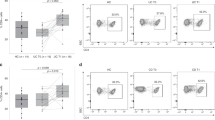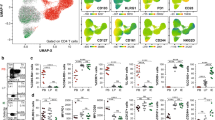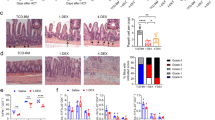Summary:
Intestinal immunopathology was studied after allogeneic stem cell transplantation (SCT) in a common clinical setup in 20 children with malignant (n=17) or nonmalignant diseases (n=3) receiving grafts from siblings (7) and unrelated donors (13). In all, 19 had total body irradiation. Duodenal biopsies at 6 and 12 weeks post transplant were evaluated by histology, immunohistochemistry, and ISEL for the detection of T-lymphocytes, inflammatory cytokines, proliferation, and apoptosis. The controls were 12 healthy children and three patients with proven intestinal graft-versus-host disease. An increased rate of apoptosis and proliferation with upregulated expression of HLA-DR antigen was detected up to 3 months post transplant in the SCT patients, even in those with a histologically normal small intestine. A low level of IFNγ and TNFα was observed in the lamina propria. The initial low density of γδ-positive T cells had recovered to normal by the time of the second endoscopy at 12 weeks post transplant. We conclude that inflammatory activity and T cell infiltration detected by immunohistochemistry may not belong to the ‘normal’ recovery of the small intestine after SCT. Increased cell turnover in the intestinal crypts continues until 3 months after SCT, suggesting either an unexpectedly long-lasting effect of transplant-related toxicity or, preferably, an ongoing subclinical alloreactive process, also present in the patients without intestinal symptoms.
This is a preview of subscription content, access via your institution
Access options
Subscribe to this journal
Receive 12 print issues and online access
$259.00 per year
only $21.58 per issue
Buy this article
- Purchase on Springer Link
- Instant access to full article PDF
Prices may be subject to local taxes which are calculated during checkout




Similar content being viewed by others
References
Terdiman JP, Linker CA, Ries CA et al. The role of endoscopic evaluation in patients with suspected intestinal graft-versus-host disease after allogeneic bone-marrow transplantation. Endoscopy 1996; 28: 680–685.
Klingebiel T, Schlegel PG . GVHD: overview on pathophysiology, incidence, clinical and biological features. Bone Marrow Transplant 1998; 21 (Suppl. 2): S45–S49.
Saarinen-Pihkala UM, Gustafsson G, Ringden O et al. No disadvantage in outcome of using matched unrelated donors as compared with matched sibling donors for bone marrow transplantation in children with acute lymphoblastic leukaemia in second remission. J Clin Oncol 2001; 19: 3406–3414.
Iqbal N, Salzman D, Lazenby AJ, Wilcox CM . Diagnosis of gastrointestinal graft-versus-host-disease. Am J Gastroenterol 2000; 95: 3034–3038.
Mowat A . Intestinal graft versus host disease. In: Ferrara JLN, Deeg HJ, Burakoff SJ (eds.). Graft-Versus-Host Disease. Marcel Dekker: New York, 1997; pp 337–384.
Snover DC, Weisdorf SA, Vercellotti GM et al. A histopathologic study of gastric and small intestinal graft-versus-host disease following allogeneic bone marrow transplantation. Hum Pathol 1985; 16: 387–392.
Hill GR, Ferrara JLM . The primacy of the gastrointestinal tract as a target organ of acute graft-versus-host-disease: rationale for the use of cytokine shields in allogeneic bone marrow transplantation. Blood 2000; 95: 2754–2759.
Andrews CA, Goldman H . Chemical and physical disorders. In: Ming S-C, Goldman H (eds) Pathology of the Gastrointestinal Tract. Williams &Wilkins: Baltimore, 1998; pp 210–217.
Abrams GD . Infectious disorders of the intestines. In: Ming S-C, Goldman H (eds.). Pathology of the Gastrointestinal Tract. Williams &Wilkins: Baltimore, 1998; pp 651–671.
Thomas ED, Storb R, Clift RA et al. Bone-marrow transplantation (second of two parts). N Engl J Med 1975; 292: 895–902.
Savilahti E, Örmälä T, Arato A . Density of gamma/delta+ T cells in the jejunal epithelium of patients with coeliac disease and dermatitits herpetiformsi is increased with age. Clin Exp Immunol 1997; 109: 464–467.
Savilahti E, Örmälä T, Saukkonen T et al. Jejuna of patients with insulin-dependent diabetes mellitus (IDDM) show signs of immune activation. Clin Exp Immunol 1999; 116: 70–77.
Klemola T, Savilahti E, Arato A et al. Immunohistochemical findings in jejunal specimens from patients with IgA deficiency. Gut 1995; 37: 519–523.
Surh CD, Sprent J . T-cell apoptosis detected in situ during positive and negative selection in the thymus. Nature 1994; 372: 100–103.
Holm K, Savilahti E, Koskimies S et al. Immunohistochemical changes in the jejunum in first degree relatives of patients with celiac disease and the celiac disease marker DQ genes. HLA class II antigen expression, interleukin-2 receptor positive cells and dividing crypt cells. Gut 1994; 35: 55–60.
Epstein RJ, McDonald GB, Sale GE et al. The diagnostic accuracy of the rectal biopsy in acute graft-versus-host disease: a prospective study of 13 patients. Gastroenterology 1980; 78: 764–771.
Sviland L, Pearson ADJ, Eastham EJ et al. Class II antigen expression by keratinocytes and enterocytes – an early feature of graft-versus-host disease. Transplantation 1988; 46: 402–406.
Stüber E, Büschenfeld A, von Freier A et al. Intestinal crypt cell apoptosis in murine acute graft versus host disease is mediated by tumour necrosis factor and not by the FasL–Fas interaction: effect of pentoxifylline on the development of mucosal atrophy. Gut 1999; 45: 229–235.
Westerholm-Ormio M, Garioch J, Ketola I, Savilahti E . Inflammatory cytokines in small intestinal mucosa of patients with potential celiac disease. Clin Exp Immunol 2002; 128: 94–101.
Garside P, Reid S, Steel M, Mowat AM . Differential cytokine production associated with distinct phases of murine graft-versus-host reaction. Immunology 1994; 82: 211–214.
Forbes GM, Erber WN, Herrmann RP et al. Immunohistochemical changes in sigmoid colon after allogeneic and autologous bone marrow transplantation. J Clin Pathol 1995; 48: 308–313.
Boismenu R, Havran WL . Modulation of epithelial cell growth by intraepithelial gamma delta T cells. Science 1994; 266: 1253–1255.
Boismenu R, Feng L, Xia YY et al. Chemokine expression by intraepithelial gamma delta T cells. Implications for recruitment of inflammatory cells to damaged epithelia. J Immunol 1996; 157: 985–992.
Acknowledgements
The skillful technical assistance of Ms Sirkku Kristiansen is acknowledged. This study was financially supported by the Nona and Kullervo Väre Foundation (MT), the Finnish Cancer Foundation (MT), the Foundation of the Friends of the University Children's Hospitals in Finland (MW-O), and the Finnish Medical Association (MW-O), and Research Funding of the Helsinki University Hospitals (USP, MT), which is gratefully acknowledged.
Author information
Authors and Affiliations
Corresponding author
Rights and permissions
About this article
Cite this article
Taskinen, M., Westerholm-Ormio, M., Karikoski, R. et al. Increased cell turnover, but no signs of increased T-cell infiltration or inflammatory cytokines in the duodenum of pediatric patients after allogeneic stem cell transplantation. Bone Marrow Transplant 34, 221–228 (2004). https://doi.org/10.1038/sj.bmt.1704559
Received:
Accepted:
Published:
Issue Date:
DOI: https://doi.org/10.1038/sj.bmt.1704559



